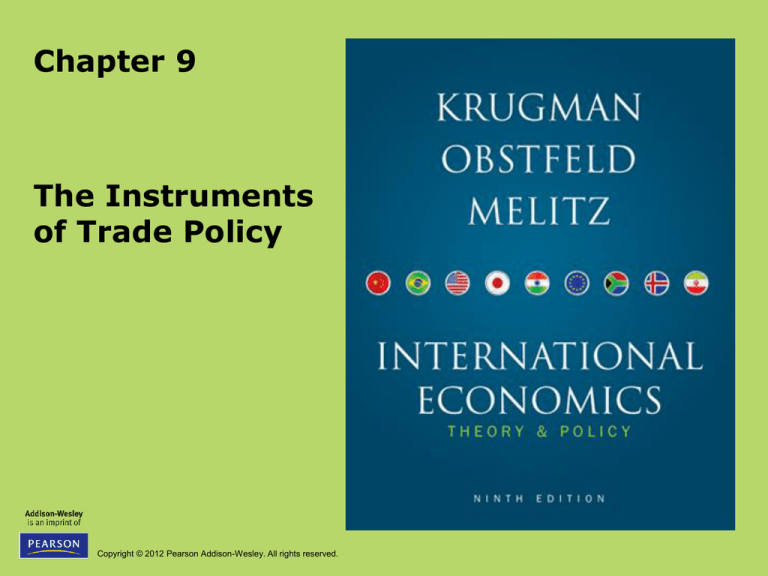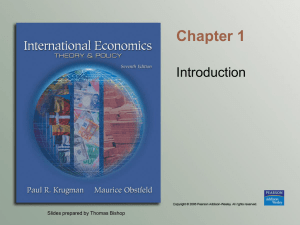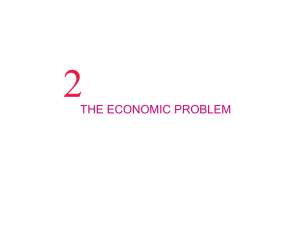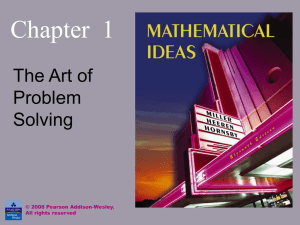
Chapter 9
The Instruments
of Trade Policy
Copyright © 2012 Pearson Addison-Wesley. All rights reserved.
Preview
• Partial equilibrium analysis of tariffs in a
single industry: supply, demand, and trade
• Costs and benefits of tariffs
• Export subsidies
• Import quotas
• Voluntary export restraints
• Local content requirements
Copyright © 2012 Pearson Addison-Wesley. All rights reserved.
9-2
Types of Tariffs
• A tariff is a tax levied when a good is
imported.
• A specific tariff is levied as a fixed charge
for each unit of imported goods.
– For example, $3 per barrel of oil.
• An ad valorem tariff is levied as a
fraction of the value of imported goods.
– For example, 25% tariff on the value of
imported trucks.
Copyright © 2012 Pearson Addison-Wesley. All rights reserved.
9-3
Supply, Demand, and Trade in a Single
Industry
• Consider how a tariff affects a single
market, say that of wheat.
• Suppose that in the absence of trade the
price of wheat is higher in Home than it is
in Foreign.
• With trade, wheat will be shipped from
Foreign to Home until the price difference
is eliminated.
Copyright © 2012 Pearson Addison-Wesley. All rights reserved.
9-4
Supply, Demand, and Trade in a Single
Industry (cont.)
• An import demand curve is the difference
between the quantity that Home
consumers demand minus the quantity
that Home producers supply, at each price.
• The Home import demand curve
MD = D – S
intercepts the price axis at PA and is
downward sloping:
– As price increases, the quantity of imports
demanded declines.
Copyright © 2012 Pearson Addison-Wesley. All rights reserved.
9-5
Fig. 9-1: Deriving Home’s Import
Demand Curve
Copyright © 2012 Pearson Addison-Wesley. All rights reserved.
9-6
Supply, Demand, and Trade in a Single
Industry (cont.)
• An export supply curve is the difference
between the quantity that Foreign
producers supply minus the quantity that
Foreign consumers demand, at each price.
• The Foreign export supply curve
XS* = S* – D*
intersects the price axis at PA* and is
upward sloping:
– As price increases, the quantity of exports
supplied rises.
Copyright © 2012 Pearson Addison-Wesley. All rights reserved.
9-7
Fig. 9-2: Deriving Foreign’s Export
Supply Curve
Copyright © 2012 Pearson Addison-Wesley. All rights reserved.
9-8
Supply, Demand, and Trade in a Single
Industry (cont.)
• In equilibrium,
import demand = export supply,
home demand – home supply
= foreign supply – foreign demand,
home demand + foreign demand
= home supply + foreign supply,
world demand = world supply.
Copyright © 2012 Pearson Addison-Wesley. All rights reserved.
9-9
Fig. 9-3: World Equilibrium
Copyright © 2012 Pearson Addison-Wesley. All rights reserved.
9-10
The Effects of a Tariff
• A tariff acts like a transportation cost,
making sellers unwilling to ship goods
unless the Home price exceeds the Foreign
price by the amount of the tariff:
PT – t = P*T
• A tariff makes the price rise in the Home
market and fall in the Foreign market.
Copyright © 2012 Pearson Addison-Wesley. All rights reserved.
9-11
Fig. 9-4: Effects of a Tariff
Copyright © 2012 Pearson Addison-Wesley. All rights reserved.
9-12
The Effects of a Tariff (cont.)
• Because the price in the Home market rises
from PW under free trade to PT with the
tariff,
– Home producers supply more and Home
consumers demand less, so
– the quantity of imports falls from QW under free
trade to QT with the tariff.
Copyright © 2012 Pearson Addison-Wesley. All rights reserved.
9-13
The Effects of a Tariff (cont.)
• Because the price in the Foreign market
falls from PW under free trade to PT* with
the tariff,
– Foreign producers supply less, and Foreign
consumers demand more, so
– the quantity of exports falls from QW to QT .
Copyright © 2012 Pearson Addison-Wesley. All rights reserved.
9-14
The Effects of a Tariff (cont.)
• The quantity of Home imports demanded
equals the quantity of Foreign exports
supplied when
PT – P*T = t
• The increase in the price in Home can be
less than the amount of the tariff.
– Part of the effect of the tariff causes the Foreign
export price to decline.
– But this effect is sometimes very small.
Copyright © 2012 Pearson Addison-Wesley. All rights reserved.
9-15
The Effects of a Tariff in a Small Country
• When a country is “small,” it has no effect
on the foreign (world) price because its
demand is an insignificant part of world
demand for the good.
– The foreign price does not fall, but remains at
Pw .
– The price in the home market rises by the full
amount of the tariff, to PT = Pw + t .
Copyright © 2012 Pearson Addison-Wesley. All rights reserved.
9-16
Fig. 9-5: A Tariff in a Small Country
Copyright © 2012 Pearson Addison-Wesley. All rights reserved.
9-17
Effective Rate of Protection
• The effective rate of protection measures how
much protection a tariff (or other trade policy)
provides.
– It represents the change in value that firms in an industry
add to the production process when trade policy changes,
which depends on the change in prices the trade policy
causes.
• Effective rates of protection often differ from tariff
rates because tariffs affect sectors other than the
protected sector, causing indirect effects on the
prices and value added for the protected sector.
Copyright © 2012 Pearson Addison-Wesley. All rights reserved.
9-18
Effective Rate of Protection (cont.)
• For example, suppose that automobiles sell in
world markets for $8,000, and they are made from
factors of production worth $6,000.
– The value added of the production process is
$8,000 – $6,000.
• Suppose that a country puts a 25% tariff on
imported autos so that home auto assembly firms
can now charge up to $10,000 instead of $8,000.
Copyright © 2012 Pearson Addison-Wesley. All rights reserved.
9-19
Effective Rate of Protection (cont.)
• The effective rate of protection for home auto
assembly firms is the change in value added:
($4,000 – $2,000)/$2,000 = 100%
• In this case, the effective rate of protection is
greater than the tariff rate.
Copyright © 2012 Pearson Addison-Wesley. All rights reserved.
9-20
Costs and Benefits of Tariffs
• A tariff raises the price of a good in the
importing country, so it hurts consumers
and benefits producers there.
• In addition, the government gains tariff
revenue.
• How to measure these costs and benefits?
• Use the concepts of consumer surplus and
producer surplus.
Copyright © 2012 Pearson Addison-Wesley. All rights reserved.
9-21
Consumer Surplus
• Consumer surplus measures the amount
that consumers gain from purchases by
computing the difference in the price
actually paid from the maximum price they
would be willing to pay for each unit
consumed.
– When price increases, the quantity demanded
decreases as well as the consumer surplus.
Copyright © 2012 Pearson Addison-Wesley. All rights reserved.
9-22
Fig. 9-6: Deriving Consumer Surplus from
the Demand Curve
Copyright © 2012 Pearson Addison-Wesley. All rights reserved.
9-23
Fig. 9-7: Geometry of Consumer Surplus
Copyright © 2012 Pearson Addison-Wesley. All rights reserved.
9-24
Producer Surplus
• Producer surplus measures the amount
that producers gain from sales by
computing the difference in the price
received from the minimum price at which
they would be willing to sell.
– When price increases, the quantity supplied
increases as well as the producer surplus.
Copyright © 2012 Pearson Addison-Wesley. All rights reserved.
9-25
Fig. 9-8: Geometry of Producer Surplus
Copyright © 2012 Pearson Addison-Wesley. All rights reserved.
9-26
Costs and Benefits of Tariffs
• A tariff raises the price in the importing country:
– consumer surplus decreases (consumers worse off)
– producer surplus increases (producers better off).
– the government collects tariff revenue equal to the tariff
rate times the quantity of imports with the tariff.
t QT = (PT – PT* ) (D2 – S2)
• Change in welfare due to the tariff is e – (b + d).
Copyright © 2012 Pearson Addison-Wesley. All rights reserved.
9-27
Fig. 9-9: Costs and Benefits of a Tariff for
the Importing Country
Copyright © 2012 Pearson Addison-Wesley. All rights reserved.
9-28
Costs and Benefits of Tariffs (cont.)
• For a “large” country, whose imports and exports
affect world prices, the welfare effect of a tariff is
ambiguous.
• The triangles b and d represent the efficiency
loss.
– The tariff distorts production and consumption decisions:
producers produce too much and consumers consume too
little.
• The rectangle e represents the terms of trade
gain.
– The tariff lowers the Foreign price, allowing Home to buy
its imports cheaper.
Copyright © 2012 Pearson Addison-Wesley. All rights reserved.
9-29
Costs and Benefits of Tariffs (cont.)
• Part of government revenue (rectangle e)
represents the terms of trade gain, and part
(rectangle c) represents some of the loss in
consumer surplus.
– The government gains at the expense of consumers and
foreigners.
• If the terms of trade gain exceed the efficiency
loss, then national welfare will increase under a
tariff, at the expense of foreign countries.
– However, foreign countries are apt to retaliate.
Copyright © 2012 Pearson Addison-Wesley. All rights reserved.
9-30
Fig. 9-10: Net Welfare Effects of a Tariff
Copyright © 2012 Pearson Addison-Wesley. All rights reserved.
9-31
Export Subsidy
• An export subsidy can also be specific or ad
valorem:
– A specific subsidy is a payment per unit exported.
– An ad valorem subsidy is a payment as a proportion of
the value exported.
• An export subsidy raises the price in the exporting
country, decreasing its consumer surplus
(consumers worse off) and increasing its producer
surplus (producers better off).
Copyright © 2012 Pearson Addison-Wesley. All rights reserved.
9-32
Export Subsidy (cont.)
• Also, government revenue falls due to paying
s XS* for the export subsidy.
• An export subsidy lowers the price paid in
importing countries PS* = PS – s.
• In contrast to a tariff, an export subsidy worsens
the terms of trade by lowering the price of exports
in world markets.
Copyright © 2012 Pearson Addison-Wesley. All rights reserved.
9-33
Fig. 9-11: Effects of an Export Subsidy
Copyright © 2012 Pearson Addison-Wesley. All rights reserved.
9-34
Export Subsidy (cont.)
• An export subsidy damages national welfare.
• The triangles b and d represent the efficiency
loss.
– The export subsidy distorts production and consumption
decisions: producers produce too much and consumers
consume too little compared to the market outcome.
• The area b + c + d + f + g represents the cost of
the subsidy paid by the government.
– The terms of trade decrease, because the price of exports
falls.
Copyright © 2012 Pearson Addison-Wesley. All rights reserved.
9-35
Export Subsidy in Europe
• The European Union’s Common Agricultural Policy
sets high prices for agricultural products and
subsidizes exports to dispose of excess
production.
– The subsidized exports reduce world prices of agricultural
products.
• The cost of this policy for European taxpayers is
almost $30 billion more than its benefits (in
2007).
– But the EU has proposed that farmers receive direct
payments independent of the amount of production to
help lower EU prices and reduce production.
Copyright © 2012 Pearson Addison-Wesley. All rights reserved.
9-36
Fig. 9-12: Europe’s Common Agricultural
Program
Copyright © 2012 Pearson Addison-Wesley. All rights reserved.
9-37
Import Quota
• An import quota is a restriction on the quantity of
a good that may be imported.
• This restriction is usually enforced by issuing
licenses or quota rights.
• A binding import quota will push up the price of
the import because the quantity demanded will
exceed the quantity supplied by Home producers
and from imports.
Copyright © 2012 Pearson Addison-Wesley. All rights reserved.
9-38
Import Quota (cont.)
• When a quota instead of a tariff is used to restrict
imports, the government receives no revenue.
– Instead, the revenue from selling imports at high prices
goes to quota license holders.
– These extra revenues are called quota rents.
Copyright © 2012 Pearson Addison-Wesley. All rights reserved.
9-39
Fig. 9-13: Effects of the U.S. Import
Quota on Sugar
Copyright © 2012 Pearson Addison-Wesley. All rights reserved.
9-40
Voluntary Export Restraint
• A voluntary export restraint works like an
import quota, except that the quota is imposed by
the exporting country rather than the importing
country.
• These restraints are usually requested by the
importing country.
• The profits or rents from this policy are earned by
foreign governments or foreign producers.
– Foreigners sell a restricted quantity at an increased price.
Copyright © 2012 Pearson Addison-Wesley. All rights reserved.
9-41
Local Content Requirement
• A local content requirement is a regulation that
requires a specified fraction of a final good to be
produced domestically.
• It may be specified in value terms, by requiring
that some minimum share of the value of a good
represent home value added, or in physical units.
Copyright © 2012 Pearson Addison-Wesley. All rights reserved.
9-42
Local Content Requirement (cont.)
• From the viewpoint of domestic producers of
inputs, a local content requirement provides
protection in the same way that an import quota
would.
• From the viewpoint of firms that must buy home
inputs, however, the requirement does not place a
strict limit on imports, but allows firms to import
more if they also use more home parts.
Copyright © 2012 Pearson Addison-Wesley. All rights reserved.
9-43
Local Content Requirement (cont.)
• Local content requirement provides neither
government revenue (as a tariff would) nor quota
rents.
• Instead, the difference between the prices of
home goods and imports is averaged into the price
of the final good and is passed on to consumers.
Copyright © 2012 Pearson Addison-Wesley. All rights reserved.
9-44
Other Trade Policies
• Export credit subsidies
– A subsidized loan to exporters
– U.S. Export-Import Bank subsidizes loans to U.S.
exporters.
• Government procurement
– Government agencies are obligated to purchase from
home suppliers, even when they charge higher prices
(or have inferior quality) compared to foreign suppliers.
• Bureaucratic regulations
– Safety, health, quality, or customs regulations can act as
a form of protection and trade restriction.
Copyright © 2012 Pearson Addison-Wesley. All rights reserved.
9-45
The Effects of Trade Policy
• For each trade policy, the price rises in the Home
country adopting the policy.
– Home producers supply more and gain.
– Home consumers demand less and lose.
• The world price falls when Home is a “large”
country that affects world prices.
• Tariffs generate government revenue; export
subsidies drain it; import quotas do not affect
government revenue.
• All these trade policies create production and
consumption distortions.
Copyright © 2012 Pearson Addison-Wesley. All rights reserved.
9-46
Table 9-1: Effects of Alternative Trade
Policies
Copyright © 2012 Pearson Addison-Wesley. All rights reserved.
9-47
Summary
1. A tariff increases the home price and the quantity
supplied and reduces the quantity demanded and
the quantity traded; also decreases the world
price when the country is “large.”
2. A quota does the same; an export subsidy does
the same.
3. Tariffs generate government revenue; export
subsidies drain it; import quotas are revenue
neutral.
Copyright © 2012 Pearson Addison-Wesley. All rights reserved.
9-48
Summary (cont.)
4. The welfare effect of a tariff, quota, or export
subsidy can be measured by
–
–
efficiency loss from consumption and production
distortions.
terms of trade gain or loss.
5. With import quotas, voluntary export restraints,
and local content requirements, the government
of the importing country receives no revenue.
6. With voluntary export restraints and occasionally
import quotas, quota rents go to foreigners.
Copyright © 2012 Pearson Addison-Wesley. All rights reserved.
9-49
Chapter 9
Additional
Chapter Art
Copyright © 2012 Pearson Addison-Wesley. All rights reserved.
Fig. 9A-1: A Monopolist Under Free Trade
Copyright © 2012 Pearson Addison-Wesley. All rights reserved.
9-51
Fig. 9A-2: A Monopolist Protected by a
Tariff
Copyright © 2012 Pearson Addison-Wesley. All rights reserved.
9-52
Fig. 9A-3: A Monopolist Protected by an
Import Quota
Copyright © 2012 Pearson Addison-Wesley. All rights reserved.
9-53
Fig. 9A-4: Comparing a Tariff and a Quota
Copyright © 2012 Pearson Addison-Wesley. All rights reserved.
9-54







